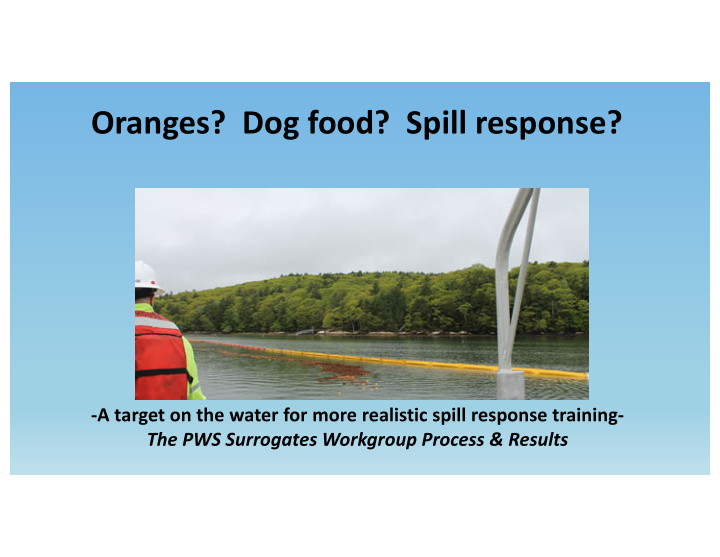



Oranges? Dog food? Spill response? -A target on the water for more realistic spill response training- The PWS Surrogates Workgroup Process & Results
Basic Concepts / Terminology Use of Simulants/Surrogates • - Serve as a “target” and training aid for responders - Add realism to exercises/drills - Equipment testing and R&D - Other uses like current/drift studies, verifying sensitive area protection strategies, etc. Surrogates are particle based. • Examples; wood chips, rubber ducks, peat moss, rice hulls, hulahoops Simulants are liquid based. • Examples; fish oil, vegetable oil, non-crude oils. No documented examples were identified in USA
More Basic Concepts… Test tank versus real life • - Physical space - Can’t duplicate complex systems with currents, tidal movements, etc Potential concerns with simulants • - An introduced substance - Operational hurdles; How to broadcast? Costs? Need to recover? - Public perception? - Behavior of given substance • Ultimate goal is to enhance training (or current studies, etc) but minimize environmental trade-offs compared to real oil
Why is PWSRCAC interested in Surrogates?
PWSRCAC’s Surrogate Project History 2008 Science Applications International Corporation (SAIC) paper • - Cataloged potential surrogate options. - Brief discussion of rules/regs that apply to surrogate use. - Problem is not what to use, but permission to use 2013 Surrogates Workshop in Seattle • - Group saw benefit in simulant/surrogate use - Understood potential environmental trade-offs existed - Could not identify a permitting pathway - Surrogate use was occurring already - Felt there needed to be policy guidance at Federal level
PWSRCAC’s Surrogate Project history BSEE continuation of 2013 efforts (approx. late 2013 to 2015) • - Clarify regulatory context for permitting - Develop a test permit - Develop surrogate release decision making guide - Present to National Response Team’s Science & Technology Committee Outcomes of BSEE workgroup • - Surrrogates vs Simulant terminology get defined - Developed decision making tool / exercise template - Work surrogates locally
PWS Surrogates Workgroup 2016 Overall Goals…. • - Identify appropriate surrogates for PWS waters - Identify usage parameters - Seek approval for a deployment involving surrogates - Conduct field trial with surrogate(s) - Document this process and any hurdles if goals are not met
PWS Surrogates Workgroup Process Participants; Alyeska/SERVS, AK Chadux, ADEC, Cook Inlet RCAC, • NOAA, Oil Spill Recovery Institute, USCG Marine Safety Unit Valdez, Dept. of Interior US F&W service, EPA, PWS Shipper representative w/ Polar Tankers, Nuka Research and Planning. Consensus Items • - Agreement that surrogates could enhance exercises & training - Could not identify a state permitting pathway Could not identify a permitting pathway • - Pathway to conduct a deliberate spill of oil - Permit related to logging operations and woodchips - Work via ADEC, division of Water Quality?
PWS Surrogates Workgroup Process Agree on specifics of an Pass to ARRT for Conduct field exercise among Comment deployment workgroup members Feed lessons Debrief exercise learned back into Document field with workgroup next surrogate deployment members exercise
Simulant / Surrogate Decision Making Tool Establish the need for surrogate use • - Research & design? - Training or exercises? - Spill fate and behavior? Select Materials to use • - Need to be suitable to task at hand - Practical considerations of surrogates and goals Develop usage plan • Seek permission for usage •
PWS Surrogate Exercise Proposal Specifics Materials • - up to 4, 2.2 cubic foot bales of peat moss - one 40 gallon bag of “Pedigree” dog food - up to 20 gallons of locally sourced wood chips Location • - Passage Canal Vicinity, just outside of Whittier Date • -September 21, 2016 with 3 dates for back-ups Game Plan • - AK Chadux working equipment, will attempt to recover materials, etc.
ARRT feedback… Materials • - up to 4, 2.2 cubic foot bales of peat moss - one 40 gallon bag of “Pedigree” dog food - up to 20 gallons of locally sourced wood chips Feedback generally positive and seemed to have green light • Pedigree (left) -vs.- Iams (right) @ hour 24 of soak
Our green light turns yellow and then red… The planned deployment was ultimately cancelled • - Contracting catch -22 - Responder Immunity Concerns - PWSRCAC does not have pollution insurance - Tough to get this insurance for this event - Had significant paper trail, but no permit per se Very tough last minute decision • Workgroup made progress on surrogate topic •
The current status…
The current status… Still much interest in making this happen • Finalized paper has gone back out to the Workgroup • Discuss specific hurdles at next ARRT meeting… • - Paper permit and official recognition and sign-off - Do we approach this from a policy or exercise perspective? - Responder Immunity - Greater agency roles may be required? PWSRCAC funding likely available if we can resurrect deployment? •
Questions or comments? jeremyrobida@pwsrcac.org 907-834-5040
Recommend
More recommend